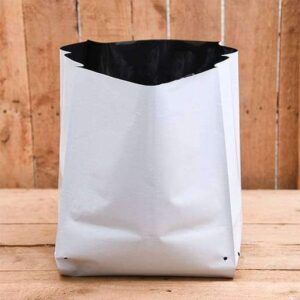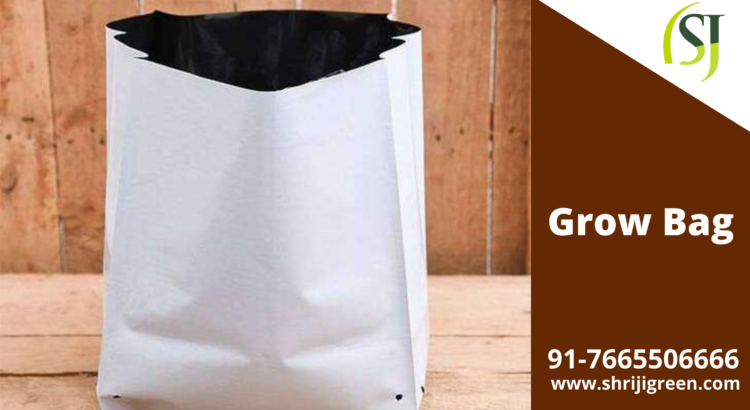Plant bags are an ideal way to grow plants and shrubs in small spaces, such as patios, decks and balconies. They provide good growing conditions, and they’re easy to use because you can pop them out of the ground when you need to water your plants or move them. Here’s how to use bags to grow plants successfully, no matter what kind of plant you want to grow or what space you have available.
Benefits of Grow Bags:
The benefit of bags is that they can easily be used by anyone to grow plants. Regardless of how much gardening experience you have under your belt.
Learn how to get the most out of your next grow bag plant.
With this, you can maximize the return on your investment in these convenient containers.
Grow bags are beneficial because they’re cheap and allow the roots to go down deep into the ground. However, if you want your plants to grow big and strong, You need to be prepared to spend time on them and pay attention to what you’re doing. It’s also important to have an idea of what plants grow best in bags, so here’s how to use them successfully for your next gardening endeavour.
What are Grow Bags?
Using Grow bags result to be an excellent way to plant larger and heavier items in your gardens, such as shrubs and small trees. These bags come in three different types: biodegradable plastic, cloth (made from natural fibres), and rubberized canvas.
Grow bag are a simple way to grow an abundance of plants without having a garden. Whether you’re a beginner or have years of experience, these containers are cost-effective and time-efficient.
Follow these steps on how to use them and watch as your vegetables and herbs take off! For even better results, plan your crops according to their growing times!
Within a week after planting tomato seedlings:
- Use long sticks or strings tied into points and secured by a thin line; stick them into the bag 1 foot apart at 2-foot height above soil level. This makes it easier for indoor positioning when sunlight becomes low.
- Position tomatoes according to your plan so that they don’t shade each other. Make sure they get equal amounts of sun, as well as 5 hours of water daily (more during periods of heat). Keep an eye on fruit growth: if any form blossoms. You should clip it off to promote more foliage growth instead.
- Water regularly to keep the soil moist but not soggy. Add fertilizer once every few weeks while also giving more light.
- Once vines start winding their way up trees and leaves start growing dark green. It is safe to say your plant is ready for harvest! Using these steps will have you growing like a pro in no time!
Why Use Bags?
Grow bags are a great way to cheaply and easily start growing vegetables, herbs, or flowers in your garden. They’re extremely durable and long-lasting. However, because they aren’t waterproofed at all, you should keep an eye on them during rainy days so that they don’t get too wet. Make sure you select plant varieties that will work well with these bags (such as lettuce).
Additionally, make sure there is proper drainage if using water retention crystals in your grow bag – otherwise water may build up and spill over into nearby containers. Even with these considerations, it’s still easy to turn a small corner of your yard into an attractive container garden.
Which Bags Are Best?
Grow bag are an easy way to add extra production space to your garden, but there are various types and sizes of bags that can be confusing. Here’s a quick rundown on which type of grow bag is best for you. The type of plant you want to grow also determines which bag is best for your needs.
 .
.
What are Grow Bags?
Grow bags are containers made from breathable fabric materials that are specifically designed for planting and growing various types of plants. They come in multiple shapes and sizes, typically resembling large, flexible bags or pots. The fabric used in their construction allows for proper aeration and drainage, promoting healthy root development and preventing issues like waterlogging and root rot.
Advantages of Grow Bags:
Grow bags offer several advantages over traditional gardening methods. Some of the key benefits include:
- Improved Drainage: The breathable fabric of bags allows excess water to drain out quickly, preventing waterlogging and ensuring optimal moisture levels for plant roots. This helps in preventing root diseases cause by overwatering.
- Air Pruning: Unlike traditional pots, the porous nature of grow bags allows air to reach the roots from all sides. When the roots come into contact with the air, they undergo air pruning, which stimulates the growth of lateral roots. This process helps develop a dense and fibrous root system, enhancing nutrient uptake and overall plant health.
- Prevents Overheating: The breathable fabric of bags helps regulate the temperature of the root zone by allowing excess heat to escape. This prevents the roots from becoming too hot, especially during hot summer months, reducing the risk of heat stress and damage.
- Portability and Flexibility: bags are lightweight and portable, making them easy to move around as need. This flexibility allows gardeners to optimize sunlight exposure or protect plants from adverse weather conditions by simply relocating the bags.
-
Better Water and Nutrient Distribution: The breathable fabric of bags allow water and nutrients to be evenly distributed throughout the growing medium. This results in more efficient water usage and nutrient absorption by the roots, leading to healthier plant growth and improved yields.
- Suitable for Various Plants: Grow bags can be useto grow a wide range of plants, including vegetables, herbs, flowers, and even small trees. They are available in different sizes to accommodate plants of various sizes and root systems.
- Space Efficiency: Grow bags can be place in compact spaces like balconies, patios, or small gardens, making them an ideal option for urban gardening. They maximize available space, allowing individuals with limit garden areas to enjoy still growing their own plants.
- Reusable and Eco-friendly: Grow bags are typically made from durable and long-lasting fabric materials. Which makes them reusable for multiple growing seasons. They are also environmentally friendly since they reduce the use of plastic pots that can contribute to plastic waste.
In conclusion, bags offer numerous advantages over traditional gardening methods. Their breathable fabric construction promotes proper aeration, drainage, and root development while providing flexibility, portability, and efficient use of space. By using bags, gardeners can create healthy and thriving plants in a convenient and sustainable way.
Choosing the Right Grow Bags: Exploring different types, sizes, and materials of grow bags and selecting the most suitable ones for your plants:
When it comes to selecting grow bags for your plants, there are various factors to consider, including the bags, their sizes, and the materials they are made from. Here is a guide to help you choose the right grow bags for your specific gardening needs:
Types of Grow Bags:
- Traditional Grow Bags: These are the most common type of bag, typically made from breathable fabric materials such as polypropylene or geotextile. They come in different shapes, like square, rectangular, or round, and are suitable for a wide range of plants.
- Smart Grow Bags: These are advance bags equippy with features like self-watering systems, built-in handles, or Velcro side openings for easy access to plants. They are design to provide convenience and enhance plant care.
- Vertical Grow Bags: Vertical grow bags are specifically design for vertical gardening, allowing you to grow plants on walls or fences. They are often made from sturdy fabric materials and have pockets or compartments for individual plants.
- Hanging Grow Bags: As the name suggests, these grow bags are design to be hung, making them suitable for balcony or patio gardening. They usually have reinforce handles or straps for easy hanging and come in various sizes.
Sizes of Grow Bags:
Grow bags are available in different sizes to accommodate various plant types and their root systems. Your size depends on the specific plants you intend to grow and the available space. Consider the following factors:
- Plant Size: Select a grow bag that provides enough space for the plant’s root system to develop. Smaller plants like herbs or lettuce require smaller bags, while larger plants like tomatoes or peppers need more giant bags.
- Root Depth: Different plants have varying root depths. Some have shallow roots, while others require more bottomless bags for proper root development. Research the specific plants you want to grow to determine their root depth requirements.
- Available Space: Consider the space where you plan to keep the bags. Measure the area’s dimensions to ensure the bags will fit comfortably.
Materials of Bags:
Grow bags are made from various materials, each with its own advantages. The most common materials include:
- Polypropylene: This is a popular material for growing bags due to its durability and breathability. It provides good drainage and is resistant to tearing or puncturing.
- Geotextile Fabric: Geotextile grow bags are made from permeable synthetic fabric that allows for optimal airflow and water drainage. They are lightweight, reusable, and have excellent heat insulation properties.
- Felt Fabric: Felt grow bags are made from non-woven fabric materials and are known for their insulation properties. They provide good moisture retention and are often used for plants that prefer moist soil conditions.
- Biodegradable Materials: Some grow bags are made from biodegradable materials like coconut coir or peat. These eco-friendly options break down over time, allowing the roots to penetrate the surrounding soil when planted directly in the ground.
Considerations for Plant-Specific Needs:
Different plants have specific requirements, so consider the following factors when choosing bags:
- Watering Needs: Some plants require more water than others. Ensure the grow bags you choose can retain adequate moisture for plants with higher water requirements or have proper drainage for plants that prefer drier conditions.
- Sunlight Requirements: Certain plants thrive in full sun, while others prefer partial shade. Choose bags that can be easily moved or positioned to provide your plants with the right amount of sunlight.
- Root Structure: Some plants have extensive root systems that require deeper or larger bags. Research the root structure of your chosen plants to select grow bags that can accommodate their needs.
By considering the type, size, and material of bags, as well as the specific requirements of your plants, you can select the most suitable bags for successful plant cultivation. Remember to also take into account your available space and gardening preferences to ensure a rewarding growing experience.





